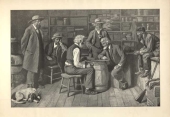The Checker Maven
The World's Most Widely Read Checkers and Draughts Publication
Bob Newell, Editor-in-Chief
Published every Saturday morning in Honolulu, Hawai`i
Noticing missing images? An explanation is here.
Key Landings

With the kind approval of grandmaster Richard Pask, The Checker Maven is pleased to present an electronic reissue of Mr. Pask's classic, Key Landings. Dealing with 25 especially important mid-game landings, this book is suitable for the intermediate to advanced player.
The content of the reissue is unchanged from the original 1990 publication, although the electronic edition has been completely reset with large, clear diagrams and other typographic improvements. The book is available for free download; follow the Richard Pask link in the right-hand column or just click here.
Our thanks go to Richard Pask for permission to republish this important work. Additionally, during the course of 2006, watch here for new editions of Mr. Pask's Key Themes and Key Endings.![]()
Can You Escape From The Growling Bear?
About a year ago, we presented a very difficult setting composed by Brian Hinkle, and just a few top players were able to solve it. This month, Brian has favored us with another of his offerings. It's of a very different nature than last year's, but it's a real teaser, and Brian has composed a little story to go along with it.

The amazing position shown below arose in the 40th and final game of the Go Where You Want World Title Match, played in the year 2012 at the San Francisco Checker Palace.
The match was tied 4-4 with 31 draws and the defending World Champion, Run Fora King (Black) only needed a draw to retain his title against his arch-rival Al X. Noisyev (White), better known as the "Growling Bear of Checkers" for his antics both on and off the checker board.
Early in this game, King played a gambit line in the Old 14th and The Bear responded by immediately giving back the man to obtain the best theoretical position--- at least in his view.
As the midgame progressed, the Bear offered Run a useless king in the single corner on square 29, which he accepted, being true to his name. In the late midgame, the Bear pitched a man in order to crown five White kings --- his patented "bear claw" tactic --- and place them on key squares, thus securing maximum pressure on the exposed Black pieces in the middle of the board.
Under extreme pressure and with the world title at stake, Run Fora King escaped with a draw in this difficult position, leaving the Growling Bear still hungry for the coveted and elusive GWYW World Title.
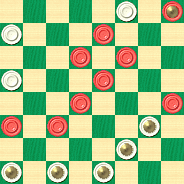
BLACK
Black to Play and Draw
B:W30,28,20,K9,K6,K4,K3,K2:BK29,26,23,22,18,15,13,12,11.
Were you able to sight solve this or did you have to move the pieces around? How long did it take you to solve it by either method?
Please send your proposed solutions and solving times to Brian Hinkle at sbhinkle@charter.net. Brian's solution and commentary will be published in the columns of The Checker Maven in the first part of 2006.
Starting with this article, we're adding FEN notation to our diagrams, at the request of our readers. If you are not familiar with FEN and PDN, a good description can be found on Wikipedia.![]()
One Year Old!
With this issue, The Checker Maven completes its first full year of publication. We're one year old today!

During our first year, we like to think we've done pretty well. Here's some of what we've been able to accomplish.
- We've gone from a handful of readers to an average weekly circulation of over 2,500, thanks to you, our loyal and valued patrons.
- We've published original problems including some of Brian Hinkle's best.
- We've published new Switcher analysis by none other than Richard Fortman.
- We've presented new electronic books by grandmaster Richard Pask.
- For better or worse, we've introduced Marvin J. Mavin and an alternate reality in which checkers is America's number one professional sport.
- We've run well over a hundred articles and maintained a reliable publication schedule.
- We've pioneered speed problems with a challenging (and unforgiving) Javascript timer.
- We've achieved a rather decent Google 'page rank' which is something completely unbiased and not subject to spin and hype.
- ... and we've done all this and much more, in a completely free, non-commercial format.
What lies ahead for The Checker Maven? Predictions are always a bit iffy, so we'll simply say that we hope to be able to continue to publish and please for a long time to come.
Jackpot

Here at The Checker Maven, we've long felt that we've "hit the jackpot" with our more than 2,500 weekly readers and the acceptance and welcome our webzine has received in its first year of publication. To celebrate, we've turned to who else but Tom Wiswell, for a nice problem which he himself has entitled Jackpot. It's not too hard (at least by Wiswell standards) but has a neat finish that you can't help but admire. The problem is co-authored by Jack Botte and looks like this:
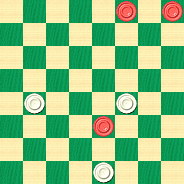
WHITE
White to Play and Win
When you've pulled the lever on your solution, click on Read More to see what Tom had to say.
[Read More]Mr. Bill Edwards: Grandmaster from Wales
The Checker Maven is pleased to present the following article about the late Welsh Grandmaster Bill Edwards. The article was written by Mr. Edwards' son, Lindus, himself a Grandmaster.
William (Bill) Edwards was born on the 28th January 1915 in the small coal-mining village of Penrhiwceiber, South Wales. At the age of twelve his father, John, taught him the rudiments of checkers, paying the youngster a penny for each elementary problem he could solve. Within a few months young Edwards accumulated a harvest of pennies and with it an interest to improve in playing strength.
At the age of fifteen his father introduced him to a local club wherein he met a dozen or so players of expert level, one of whom was the gifted crossboard player William Morgan who took the precocious youngster under his wing for several years. Morgan’s fine tuition evidently reaped a great reward when Bill, at the age of just nineteen, won the Glamorgan Open Championship without the loss of a single game in a tournament which attracted the top Welsh players of the day.
Only a few weeks after this impressive performance a serious coal-mining accident crushed Bill’s left foot causing him to be hospitalised for several months and removed him from the checker-playing scene for the next three years until he decided to enter his first Welsh Open Championship. With only a month to prepare he managed to win this prestigious event ahead of such notables as Graham Davies (later to become the British Open Champion), Alf Huggins (also later to become the British Open Champion and World Correspondence Champion), Ivor Edwards (unrelated) and Ernie Rees to name but four among many players of grandmaster strength.
Following several additional major victories Bill joined the Royal Engineers and distinguished himself by being invalided out of the army after a six-year tour of duty in World War Two.

Mr. Bill Edwards, circa 1950
With hardly any preparation Bill entered the English Open Championship in 1948 where he met and befriended the legendary Derek Oldbury. It was only in the final that Bill succumbed to the phenomenally strong crossboard player Percy Crabbe. But not without incident. This was a final now made famous by the incompetence of the time-keeper who announced that Bill needed to make eighteen moves in the two remaining minutes when, in fact, only two moves were required! Attempting to play the required number of moves in so short a time proved fatal with Crabbe capitalising upon an understandable blunder.
Following three more Welsh Championships victories between 1953 and 1955 Bill decided upon permanent retirement from the game and married shortly after.
During the winter of 1971 I discovered some old documents in the attic which revealed the illustrious checker-playing career of my father which, hitherto, he had only briefly talked about. Intrigued by his past I asked whether his interest might be rekindled to the extent of playing in another tournament, at which point he seemed dubious. Within a day or so I bought a checker board and pieces as I was desirous of seeing how skilful he was! To my astonishment I was shown an entirely different game to the one I knew as a small child and wanted, quite naturally, to learn more. Having a checker board and pieces before him for the first time in sixteen years must have served as the catalyst in his comeback, for it was only a few days later that my father and I visited Cardiff YMCA – the scene of many Welsh Championships - in pursuit of meeting the players whose skills had graced that wonderful Victorian building.
After an hour’s wait two gentlemen in their late eighties walked into the room. My father strode up to them and extended his hand as if the many years which separated their last meeting meant nothing. “Bill Edwards!” exclaimed the older of the two. “And you are my old friends Steve James and Stan Bassett,” replied my father. I looked on stupefied and said, “Now I see why checker players have to have such great memories!”
Within a couple of months of that memorable meeting my father began to study such books as ‘World Championship Checkers’ and as many others containing the games of his idol, Dr Marion Tinsley, as possible.
In May of that year my father decided to enter the British Open Championship in North Wales. By a remarkable coincidence, Graham Davies of South Wales was also making a comeback to the game after an almost equally long period.
After eleven gruelling sessions and twenty-two games Graham Davies emerged the winner of that contest with 15 wins and no losses – just ahead of my father who scored 12 wins and no losses.
A year later, and now armed with a knowledge of three-move play which, hitherto he had never studied, Bill won the Scottish Open Championship ahead of John McGill, Tom Watson, James Marshall and Jimmy Grant.

Winner of the 1987 Irish Open
Bill’s golden years were between 1979 and 1987 during which time he won five consecutive English Open Championships, together with several major freestyle tournaments.
When Bill played in the United States-United Kingdom International Match of 1989 he won seven wins out of the eleven managed by the entire UK & Ireland team. When one considers that only five wins were scored in the one hundred and eighty games played by the other nine team members, it makes one realise how strong a player my late father was. In that contest Bill scored two draws with Asa Long and beat the likes of Paul Davies, but it was at a time when he was almost at the peak of his ability.
In 1994 Bill journeyed to Scotland and won the Centenary Scottish Open Championship. Winning this event persuaded him to continue playing in spite of declining health and in 1995, at the age of eighty, he won the British Open Championship without the loss of a single game ahead of Pat McCarthy, Tom Watson and several other notable grandmasters.
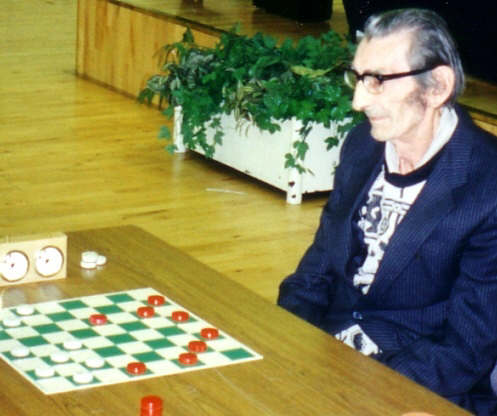
At the 1997 English Open
Following this astonishing success he decided to issue a challenge for three-move championship of the world. At the age of eighty-one and in rapidly deteriorating health Bill journeyed unaccompanied to Ireland in an ill-advised attempt to wrest the title from Ron King of Barbados. Being provided with an inadequately heated room in a sub-standard hotel, whilst Ron King enjoyed the sumptuous comfort of a five-star hotel across the road, did nothing to enhance his chances of winning the match, to say the least of the appalling toll on his health. Seeing his deterioration in health the kindly manager of the hotel at which Ron King was cordially treated in the lap of luxury took pity upon the octogenarian and insisted he stay at his hotel free of charge.
With thoughts of returning home as quickly as possible Bill Edwards, the man who had won almost thirty major championships, not surprisingly played the poorest checkers of his life.
With literally only weeks to live, in chronically poor health and suffering great pain, Bill attempted to win the Droitwich Open, which is a twelve-round freestyle event over a weekend, and was forced to withdraw after only a few sessions, but not before winning his last game with a magnificent touch so typical of his wonderful crossboard ability.
As a player my father was blessed with a phenomenal memory, often memorising dozens of games daily and retaining them for use in tournaments years later! It was not by memory alone however that he was able to defeat the finest players of Great Britain and Ireland over almost thirty years. His crossboard skills were of the highest order, often visualising twenty-five moves in the most complicated positions. I tested this ability on countless occasions, often presenting him with the most convoluted positions imaginable. The outcome was always the same.
After a couple of minutes he would say, “Yes, I can see it now. The piece on square twenty-seven will be lost in twenty-four moves!”
As a person he was liked instantly by all who met him. He exuded a calm at the checker board such as I have never seen and was a quality which undoubtedly assisted him to win a unique number of major tournaments.
Moving a piece on a checker board was something he did with an elegant style and was sheer poetry in motion to behold. Always modest in success and congratulatory to the few who beat him Bill will be remembered not only as the greatest Welsh player to date, but as a person with a big heart who loved everyone.
William “Bill” Edwards died peacefully at Prince Charles Hospital, Merthyr Tydfil, South Wales, during the early hours of Thursday the 23rd July 1998 aged eighty-four years.
Only hours before his passing he asked me how the British Open Championship was progressing–- an indisputable testimony to his deep love of checkers. Pat McCarthy was to later write to me saying, “Your father’s play had a touch of genius about it.” Coming from a player my father regarded as a phenomenal crossboard player this was a fine eulogy indeed.
---Lindus John Edwards.

Penrhiwceiber, Village of Mr. Edwards' Birth
Here is a game played by Mr. Edwards in the 1982 British Championships in which he defeats the legendary Derek Oldbury. Annotations are by Lindus Edwards.
1982 British Championship Match
Edwards: Black
Oldbury: White
| 10-15 | 24-20 |
| 7-10 | 28-24 |
| 3-7 | 23-19 |
| 9-14 | 22-17 |
| 5-9 | 17-13 |
| 15-18 | 26-23 |
| 1-5 | 31-26 |
| 11-16 | 20-11 |
| 8-15 | 26-22 |
| 4-8 | 21-17---A |
| 14-21 | 23-14 |
| 10-26 | 19-3---B |
| 9-14 | 30-23 |
| 21-30 | 32-28 |
| 8-11 | 23-19?---C |
| 11-16 | 19-15 |
| 16-20 | 15-11 |
| 14-18 | 3-8 |
| 6-9 | 13-6 |
| 2-9 | 11-7 |
| 30-26 | 8-11 |
| 26-23 | 7-2 |
| 23-32 | 11-15 |
| 20-27 | 15-22---D |
| 27-31 | 2-6 |
| 9-13 | 29-25 |
| 32-27 | 6-10 |
| 27-23 | 25-21 |
| 12-16 | 10-14 |
| 16-19 | 14-10 |
| 23-27 | 10-7 |
| 19-23---E | Black Wins |
A---Or 22-17 as played by Newell Banks vs. Marion Tinsley as follows: 8-11, 25-22, 18-25, 29-22, 11-16, 22-18, 15-22, 19-15, 10-28, then either 17-1 (Tinsley-Banks) or 17-3 (Tinsley-Hellman).
B---19-1 is the better way.
C---This permits 11-16 and places the piece on 27 in jeopardy. Instead, 24-20 11-15, 27-24, 30-26, 23-19, 6-10, 29-25 Drawn. D. E. Oldbury vs. E. Frazier, 1965 match.
D---"There are other man-down ideas that might have been tried, but to no avail" (DEO).
E---A nicely played win.![]()
Happy Thanksgiving to our American Readers

The Checker Maven wishes a happy Thanksgiving holiday to all our American readers; and if you are taking to the road or the skies, please make your trip a safe one.
We'd like to also take this opportunity to mention again that, during the hectic holiday season, from late November through early January, we generally publish one article per week instead of two.![]()
Total Insanity

This month we bring you what is possibly the most insane stroke problem ever conceived. It's a completely artificial situation and has no practical play value, but as a test of visualization it is unrivaled.

WHITE
White to Play and Win
Try this problem without (1) using your computer, and (2) getting out an extra checker set so you can move the men around on your board. In other words, be crazy and sight-solve it!
When you have the answer, or have completely gone off your rocker, click on Read More for the solution.![]()
Two Final Not-So-Easy Pieces
Today, we reach the end of the "introductory" tactical problems and examples in our ongoing electronic republication of Willie Ryan's celebrated Tricks Traps & Shots of the Checkerboard. The problems have been getting harder and harder... and we haven't even gotten to the main parts of the book! Here's Willie once more:
BLACK
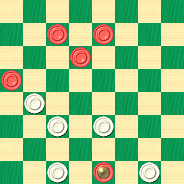
WHITE
White to Play and Win
"Many a losing position has been won or drawn, in the last minute of play, by a brilliant series of startling moves. Example 17 pictures white in what appears to be a hopeless predicament; yet white can turn the tables to win by a neat 'backup and throwback' stratagem this is as pleasing as it is deceptive. The backup idea is employed to get tactical support or 'backing' from an opponent's piece--- to use that piece as one of your own men. All compound shots are essentially based on the backup principle. A throwback or 'pitch-out' is a clever method of ousting an opponent's king from your king row (by sacrificing one or more pieces) in order to capture it on the bound.
BLACK
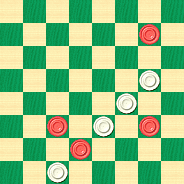
WHITE
White to Play and Win
For our closing study, Example 18, we feature an advanced player's problem that brings into play some of the tactical ideas we have discussed in the preceding examples. Instead of expecting our beginners to solve this chestnut, we will briefly review the solution and denote the play, step by step."
Whoa, just a minute there, Willie! Let's let our readers try it on their own first! After all, they can always click on Read More to see the solutions!![]()
KingsRow Digs Into the Last of the "Lost" 3-Move Ballots

In the 1930s, the 3-move restriction style of play was introduced as a follow-on to 2-move restriction and the earlier go-as-you-please (unrestricted) play, in order to hopefully "energize" tournaments and reduce the number of drawn games. Leaving out duplicates and immediate losses, there are 174 possible 3-move ballots; initially, 137 of them were considered "playable."
Over time, that number went up to 144, and recently, 12 additional ballots have been added to the deck (see Richard Pask's book, The Golden Dozen, available for download on this site). Now, openings formerly thought to be overly one-sided, such as the Skunk, the Black Hole, the Twilight Zone, and others, are being seen in high-level competition.
This still leaves 18 ballots believed to be unplayable. But Ed Gilbert, author of the world-class KingsRow computer checker engine, is doing deep automated analysis to test this assumption.
Having recently completed calculation of a 10-piece endgame database (some 250 or more gigabtyes in size, including every possible position with 10 or fewer pieces on the board), Ed thought that intensive "book" analysis was the order of the day. After all, computer analysis, (along with skilled human analysis, of course) was a major factor in bringing the latest 12 ballots into play. Could there be hidden secrets in the remaining 18 ballots still thought to be a loss?
Ed expects book analysis of these last openings to take a few months. He doesn't necessarily expect to find that one of these is indeed playable, but he'll know the answer one way or the other in due course.
Ed explains his procedure and motivation as follows, with an interesting reference to Italian checkers: "I set up a computer to work on a book for the 18 'lost' ballots with KR 10 (KingsRow with the 10-piece database). I will let it run until all are confirmed lost. The reason I started this is that I just finished the 9-piece and partial 10-piece databases for the Italian game. What I found interesting is that I played out the 9 Italian ballots that I had labeled as probable losses, and in one of them it dropped out of book and instantly showed a database draw! I probed some of the other 'winning' attacks and think I might have found a draw for another one. I will have to build books to really confirm this, but it's possible that the 8-piece book was wrong about some of these lost ballots. Wouldn't it be neat if something similar happened with English checkers? If course I have already played out the 18 lost ballots with KR10 and did not find any obvious draws, and I think it is a lot less likely." (Playing out a position is a less conclusive but faster type of analysis than building a book.)

KingsRow Author Ed Gilbert
Ed followed up later: "The book generator has only been working for about 3 days, but already most of the lost ballots have scores around 90 (meaning they are indeed losses). While it will probably take a couple of months to fully complete this job, if there are any that have drawing chances I may know much sooner than that. There are three left that still have low scores--- the Shark, the Cheetah, and the cousin to the Black Widow (12-16 23-19 16-23). While it is not very likely, I am hoping for a draw in one of these!" (In KingsRow, scores approaching 100 are just about certain losses. The lower the score, the more balanced the position. Scores of around 30 show a definite advantage but short of a sure win; scores around 10 or lower are highly likely to indicate drawn positions.)
We'll report further on Ed's results as they become available.![]()
Checker School: Coming From Behind, Part 2

Today we present the second in our series of three lessons on classic "man down draw" positions. No one who has played more than a few games has failed to encounter some of these seemingly lost situations, and, most likely, missed out on a possible draw.
The position below is attributed to Dr. T. J. Brown, and found in Ben Boland's classic, Famous Positions in the Game of Checkers:
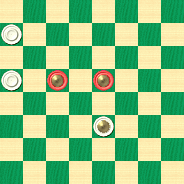
BLACK
Black to Play and Draw
We immediately note a similarity to last month's lesson: a single Black king is holding two White men at bay on the edge of the board. Once again, there is hope, and with careful play, Black can save the draw. (And we do mean careful play; a typical learner's attempt, 18-15, loses at once to 28-24.)
Work this one out for yourself, and then click on Read More for a detailed solution.![]()
The Checker Maven is produced at editorial offices in Honolulu, Hawai`i, as a completely non-commercial public service from which no income is obtained or sought. Original material is Copyright © 2004-2026 Avi Gobbler Publishing. Other material is public domain, AI generated, as attributed, or licensed under CC1, CC2, CC3 or CC4. Information presented on this site is offered as-is, at no cost, and bears no express or implied warranty as to accuracy or usability. You agree that you use such information entirely at your own risk. No liabilities of any kind under any legal theory whatsoever are accepted. The Checker Maven is dedicated to the memory of Mr. Bob Newell, Sr.

